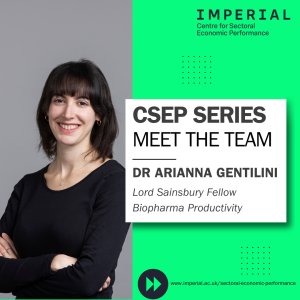
Can you describe your research journey and the key themes that define your work in health economics and public policy?
I am a Research Associate in the Economics and Public Policy department at Imperial College London, jointly affiliated with the Centre for Sectoral Economic Performance (CSEP) and the Centre for Health Economics & Policy Innovation (CHEPI). I completed a PhD in Health Policy and Economics at the LSE, where my dissertation examined how patient organisations shape pharmaceutical innovation and access. Methodologically, that work combined quantitative analyses with qualitative evidence to capture how incentives, information, and advocacy intersect across the R&D and reimbursement lifecycle. I also interested in how governance processes can be embedded within the pharmaceutical sector, particularly around transparency requirements and where they fall short. My research has been published in The Lancet Oncology, Social Science & Medicine, Value in Health, and BMJ Open, and I continue to collaborate with colleagues across disciplines to address policy-relevant questions in this space.
Your work bridges health economics and innovation policy—how are you currently exploring the role of emerging technologies, like AI, in shaping pharmaceutical R&D productivity and access to medicines?
I am currently working in a CSEP–funded programme on pharmaceutical R&D productivity that analyses how technology adoption and market structure shape drug development performance in the UK life sciences sector and internationally. I am also supporting a European Commission–funded project, called Hi-PRIX, which investigates how incentives for innovation can be aligned with equitable and timely patient access to effective medicines. A particularly interesting aspect of this agenda is the opportunity to explore the rapidly evolving AI tools landscape in the pharmaceutical sector, for example, evaluating how different AI tools are being integrated across target identification, trial design, and evidence synthesis, and what this implies for productivity. The sector is experiencing a period of rapid change, and I feel it is extremely important to think how the research we produce can be translated into recommendations that regulators and policymakers can act on to improves people’s health.
Your work touches on several aspects of the pharmaceutical sector. Can you tell us about the key themes or focus areas of your research, and how they inform policy and practice in health economics?
My work spans three interlinked strands: (i) pharmaceutical innovation and R&D productivity, including the drivers of success and attrition across the pipeline; (ii) regulation and health technology assessment (HTA), with an emphasis on evidence standards, uncertainty, and value for money; and (iii) the commercial determinants of health, particularly how market power, pricing practices, and strategic behaviour shape access and affordability. I am especially interested in how emerging biomedical technologies and stakeholder incentives interact to determine which medicines are developed, how they are evaluated, and how quickly patients can access them.
How do you see your role contributing to CSEP’s mission?
CSEP’s mission is to generate sector-level insights that inform policy and practice. My contribution is to bring an applied empirical toolkit, econometrics, document and text analytics, and policy evaluation, to help diagnose bottlenecks in drug development and to understand which policy levers are most likely to improve innovative output and patient access. I also enjoy collaborating across disciplines and supervising junior researchers, which helps grow CSEP’s capacity to deliver timely, policy-relevant research.
In what ways do you hope your work at CSEP will contribute to improving how health systems balance innovation, affordability, and access to medicines?
First, to deepen the evidence base on how technology, organisational capabilities, and market design impact biopharma productivity in ways that are compatible with affordability and equitable access. Second, to strengthen the bridge between research and implementation by working closely with partners in government and industry so that our findings inform regulation, HTA processes, and funding models. An additional benefit of being at CSEP is exposure to diverse methodological approaches across sectors. For instance, AI-enabled techniques employed by colleagues analysing firm-level data in the aviation sector have proven directly transferable to one of our pharmaceutical projects, which I believe is a great example of how cross-sector collaboration advance research.